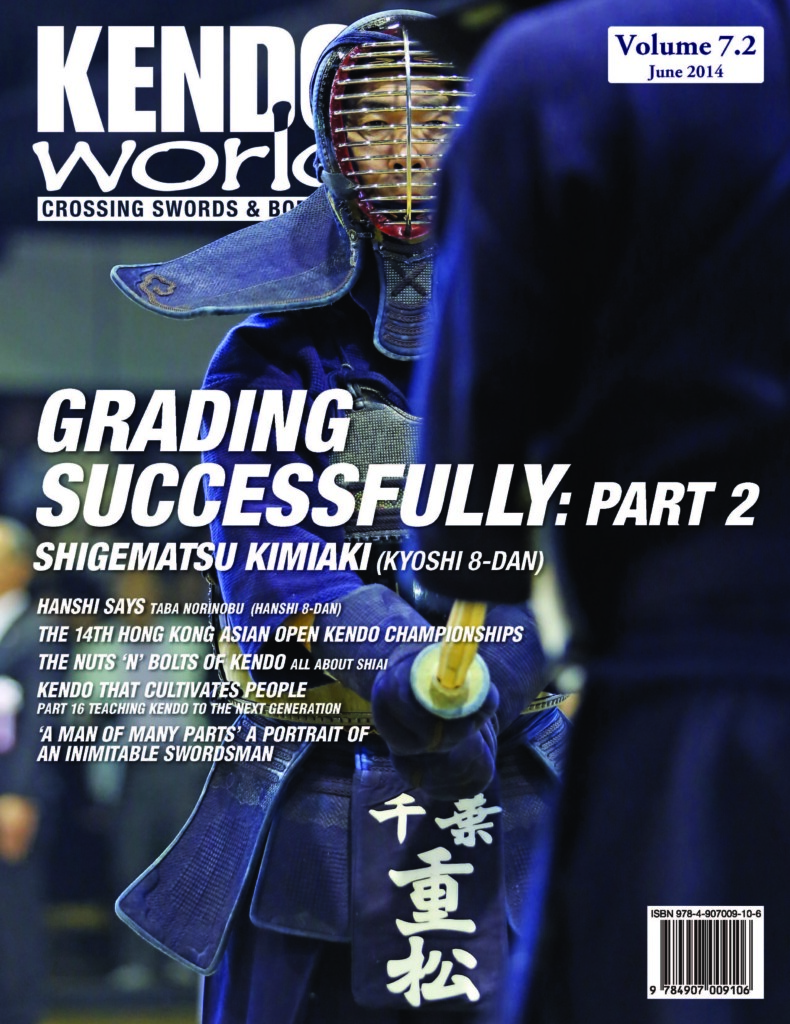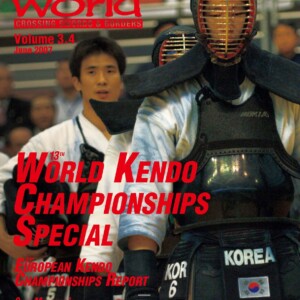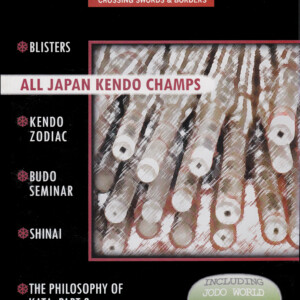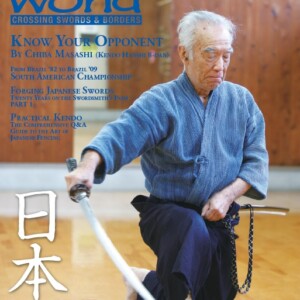
Kendo World 7.2

Editorial
By Alex Bennett
Kendo World’s Alex Bennett has recently finished a translation of the bushido classic Hagakure. In his editorial he discusses the relevance of Hagakure to kendo and the lessons that can still be learned from it.
Obituary: Miyako Tanaka Price
By Kurt Schmucker
Kurt Schmucker looks back at the life of naginata Hanshi Miyako Tanaka Price, who recently passed away.
Hanshi Says
Hanshi Says is a popular series in which Japan’s top Hanshi teachers give hints of what they are looking for in grading examinations based on wisdom accumulated through decades of training. This issue features Taba Norinobu-sensei from Ibaraki prefecture who passed the 8-dan examination in 1990, and was awarded the title of Hanshi in 1998.
“When I am on an examination panel for 8-dan examinations, the main thing that I am looking for is whether or not the candidate demonstrates an understanding of correct kendo theory. Are they fighting their opponent from an interval that seems close to them but far away for the opponent? Are they seizing the right opportunities to strike? Are they attacking with ki-ken-tai-itchi? And, are they demonstrating steadfast zanshin at the end of each attack? The act of applying pressure is essentially a clash of two minds, and the key for success is how well each candidate is able take the initiative in the seme process and attack and defence. Strong “ki-zeme” ‒ overcoming your opponent with your spirit and presence ‒ is of the essence.”
Embrace the Failing
By Boris Jansen
Dutch National Team member reflects on passing 6-dan, and the positives to be gleaned from failing.
“I am still on a high after passing my kendo 6-dan in August 2013. The preparation, failing, reflection, struggling and finally passing the exam, turned out to be a much greater experience than I initially expected. The failing forced me to take a step back and helped me to transform my kendo into what I believe is more mature and varied, and on top of it, just more fun. In this article, I would like to share my experience regarding my three attempts and highlight some of the requirements which I think are key in order to pass.”
Grading Successfully: Part 2
By K8-dan Shigematsu Kimiaki-sensei
In “Grading Successfully Part 2”, Shigematsu Kimiaki-sensei, a kendo instructor with Chiba Prefectural Police Force, gives a detailed explanation of how to approach a grading. In this, the second of three instalments, he discusses the importance of kihon, the correct attitude to training, types of keiko, ki, and kyojitsu. This is an essential guide for those who are about to take a grading, particularly for the higher dan levels.
FIK Anti-Doping Compliance
By Dr. Darryl Tong
As an official member of SportAccord (formerly known as GAISF) the International Kendo Federation (FIK) set up an anti-doping committee to conform to World Anti-Doping Agency (WADA) regulations pertaining to doping. As FIK affiliates, each national federation and participants in FIK activities must abide by the FIK Anti-Doping Rules compiled in accordance with the World Anti-Doping Code. FIK Anti-Dopin Committee Chairman Dr. Miyasaka Masayuki discusses its impact with Dr. Darryl Tong of the University of Otago, New Zealand.
Nuts ‛n’ Bolts of Kendo: All about Shiai
By Nakano Yasoji (Hanshi 9-dan)
In this article, Nakano-sensei discusses how to be successful in shiai.
“I think of keiko as a kind of shiai. Kakari-geiko is different, but in ji-geiko you should always aim to score the first point (shodachi). Even if you are doing keiko against your senpai or sensei, always try to get the first successful strike in, just as you would in a shiai. If you engage in keiko with this mind-set but get hit instead, accept it with humility and say “mairimashita” (I concede).”
This is the last in the series.
The 14th Hong Kong Asian Open Kendo Championships, March 1-2, 2014
By Dr. Stephen Robert Nagy
When we think of prestigious kendo tournaments, the World Kendo Championships (WKC), the All Japan Kendo Championships, and other major tournaments held in Japan usually spring to mind. These are competitions in which we can see the best kendo in the world, but there are other important locations where kendo is being practised and competed in at very high levels. More importantly, the level that is being exhibited at these tournaments is not static. It is increasing thanks to the leadership of various kendo organisations and the plethora of teachers in the world that not only dedicate themselves to passing on the traditions of kendo, but are also committed to fostering excellence in their students. This article will introduce some of the highlights of the 14th Hong Kong Asian Open Kendo Championships (HKAOKC).
Reidan Jichi: Kihon Dōsa – Part 6: Kirikaeshi
By Ōya Minoru (Kendo Kyōshi 7-dan)
Kihon-dōsa, or basic movements, refers to kamae, footwork and manipulation of the shinai. In other words, it entails all of the principles behind the striking and thrusting movements for scoring yūkō-datosu (valid attacks) in kendo. This article looks at kirikaeshi.
“Kirikaeshi is an indispensable exercise in kendo. It is a basic exercise that contains all of the important technical elements of kendo, and is a useful means for fixing bad habits that may have crept into your basics skill set. It is absolutely vital to include kirikaeshi into your training regime, regardless of what rank you hold.”
sWords of Wisdom: “Shōbu wa saya no uchi” (Victory attained with the sword still sheathed.)
By Alex Bennett
This instalment is about “iai” – the art of drawing the sword and making a cut.
“Iai (iaijutsu) originally described the technique of drawing one’s sword in a flash to cut down an enemy about to attack. In accordance with the teaching, “Tsune ni ite, kyū ni awasu”, which translates along the lines of “being constantly ‘prepared’ (i) to ‘meet’ (ai) the enemy in an instant”, the iai encounter was all over in the blink of an eye. The sword was removed from its scabbard so quickly and effectively that the woeful recipient of the blow could not possibly know what had struck him.”
Kendo in the Snow
By Magnus Johansson
Magnus Johansson reports on the 1st Annual Swedish Kangeiko was held in Skellefteå, Sweden. Kendoka from Sweden, Norway, England, Wales and Hungary gathered for a weekend of kendo training at Skellefteå Budokan. It was led by Hungarian sensei Tibor Bárány, 7-dan and focussed on everything from basic footwork to shiai and kata.
An Innovative Method for Kendo Shiai
By Kihara Motohiro, Kusama Masurao, Yokoyama Naoya and Bando Takao
Many kendo players adopt defensive postures to negate their opponent’s attack. Although such poses do not infringe the rules of competition, they detract from the quality and spirit of kendo. Our research group conducted an experiment in which college-level kendo competitors engaged in matches, but were also judged according to the postures they assumed during the bouts. Their comments and opinions were collated to assess the viability of a new adjudication system for kendo matches.
What’s this about the new rules for blocking?
By Andy Fisher
A few months ago there was a lot of discussion among the internet kendo community about the introduction of some new rules for junior high school level shiai in Japan, and the topic recently resurfaced on the Kendo World forums. Basically, the rule addresses young practitioners who use an overly defensive strategy in matches in order to avoid losing points, particularly by employing a defensive stance. This article will examine that rule change.
Kendo that Cultivates People: Part 16
By Sumi Masatake (Hanshi 8-dan)
“Teaching Kendo to the Next Generation: Part 2” is the sixteenth and final part of the “Kendo that Cultivates People” series. This instalment will focus on how interpersonal relationships cultivate the mind of the individual and will discuss the manner in which kendo is currently practised by young people and what areas need improvement.
Film Review: Uzumasa Limelight
By Michael Ishimatsu-Prime
“Set in Uzumasa, Kyoto, the Mecca of jidai-geki, Uzumasa Limelight follows Kamiyama, an aging kirare-yaku, who struggles to find work after Edo-Zakura (Cherry Blossoms of Edo), the jidai-geiki TV show that has been his home for the last 40 years, is cancelled by the new studio head.”
A kirare-yaku is a type of actor/stuntman whose primary job is to be cut down by a sword in samurai movies. This film stars perhaps Japan’s most famous kirare-yaku, Fukumoto Seizō. He is probably best known to non-Japanese audiences as the “Silent Samurai” in The Last Samurai.
Historical Oddities: The Works of Tetsuya Noguchi
By Jeff Broderick
In March 2014, Tokyo’s Nerima Ward Museum of Art was transformed into another world by the work of Tetsuya Noguchi, whose strange yet familiar samurai figures, rooted in history while being somehow outside of time, evoke subtly mixed emotions. Jeff Broderick interviews artist Tetsuya Noguchi about his samurai figures that blend the ancient and the modern.
Book Review: Hagakure by Alexander Bennett
Reviews of Alexander Bennett’s new translation of the bushido classic Hagakure.
Shinai Sagas: The Champion
By Charlie Kondek
In Charlie Kondek’s latest Shinai Saga, there is big news as the reigning All Japan Champion visits the U.S. to conduct a seminar at Mokkei Dojo.
The Naginata Monbushō Seitei Kata
By Baptiste Tavernier
The last step in naginata’s evolution during the war was made by Sakakida Yaeko, a Tendō-ryū exponent who was commissioned by the Ministry of Education to create a new official naginata vs. naginata system that would be used as a component of the tairenka (physical discipline) classes in Japan’s schools. This method consisted of basic techniques and a set of seventeen kata that would later become known as the “Monbushō Seitei Kata”.
Nito – Part 8: Strategy for Nitō
By Yamaguchi Masato
Yamaguchi Masato’s series on nitō kendo finishes with a look at strategy and how to fight a nitō practitioner.
‘A Man of Many Parts’, A Portrait of an Inimitable Swordsman: Ronald Alexander Lidstone (1895 – 1969): Part 1
By Paul Budden
In this two-part series, Paul Budden discusses the very interesting life of one of the pioneers of British kendo, Ronald Alexander Lidstone.
An Oasis of Equality in the Male-Dominated World of Sport? Finnish Women’s Experience of Kendo
By Rita Dekšnytė
This article will introduce some of the findings of a qualitative research study aimed at exploring the experiences of three highly skilled Finnish female kendo athletes. It will focus on one of the themes emerging from the data, “the sports context”, and discuss the ways that the kendo sports framework and culture mediates women’s experiences.
Book Review: GoGo Ninja by Marco Garcia
By Charlie Kondek
Charlie Kondek reviews GoGo Ninja, a book for children that aims to impart the valuable lessons that can be gleaned through its practice.
AVAILABLE IN PRINT AND KINDLE VERSIONS AND ON THE BUDO BOOKS APP IN E-BOOK FORMAT! SEE THE LINKS BELOW!!
























No comments yet.